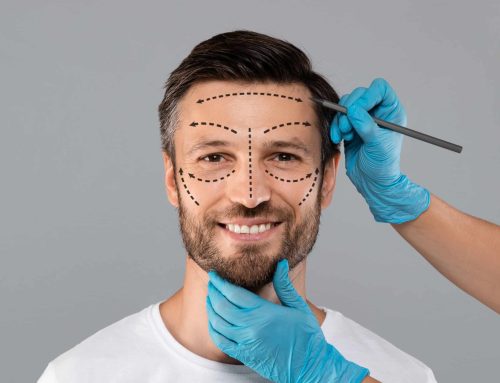If you have multiple missing teeth, you’re likely looking for replacements. In that case, your best options are to either get a partial denture or a dental bridge. Each of these treatments could fill your tooth gaps and thus restore your smile! That said, there’s a chance you don’t know the difference between partial dentures and dental bridges. Fortunately, your Frisco dentist can help you make the right choice. Here’s a summary of partial dentures, dental bridges, and which is best for you.
What’s a Partial Denture?
Like a full one, a partial denture is an appliance that replaces pearly whites. However, it only includes a few artificial teeth rather than an arch’s worth.
Each partial denture has a gum-colored plastic base that attaches to tooth replacements. As a result, the prosthetic is removable and can be taken out for cleaning or sleeping. It also links to your mouth using clasps that clip onto your natural teeth.
Sometimes, a partial denture’s plastic base may connect to a metal framework.
Cast Framework Partial Dentures Explained
Cast framework partial dentures are a type of dental prosthesis used to replace missing teeth. They are distinguished by their metal framework, which supports the acrylic and artificial teeth.
Key Features:
- Metal Framework: The foundation is made of a thin, durable metal, making them less noticeable compared to full acrylic models.
- Stability: These dentures are primarily supported and retained by the remaining natural teeth, providing exceptional stability.
- Clasp Design: The clasps are carefully crafted to hold the denture in place, allowing for adjustments that make them less visible than traditional wire clasps.
- Tooth Modification: Existing teeth may be slightly altered to ensure a perfect fit and to prevent interference from the clasps.
- Durability: The metal framework is robust, making it less prone to breaking than acrylic dentures. It also rests on the teeth rather than the gums, preventing the dentures from sinking below the teeth’s level.
- Comfort: Since there is minimal contact with soft tissue, users typically experience fewer sore spots.
Advantages of Cast Framework Partial Dentures
Cast framework partial dentures offer several compelling advantages over other types of partial dentures:
Enhanced Stability
These partial dentures are primarily supported and retained by your natural teeth, making them incredibly stable compared to their counterparts. This stability allows for better functionality while chewing and speaking.
Minimal Visibility
The metal framework in these dentures is cast extremely thin, making it much less noticeable than bulkier acrylic frameworks. The clasps are designed to be discreet, often positioned where they blend seamlessly and are less visible than traditional wire clasps.
Durability
Made from strong metal, the framework is exceptionally durable and resistant to breaking, unlike acrylic models. The metal rests on the teeth rather than the soft tissue, which minimizes the likelihood of the dentures sinking or shifting, ensuring a more consistent fit over time.
Reduced Tissue Irritation
With minimal contact on the soft tissues of your mouth, cast framework partial dentures significantly reduce the likelihood of sore spots and discomfort, offering a more comfortable wearing experience.
Functional Fit
The design allows for slight alterations to your teeth so you can close your mouth completely without interference from the clasps. This ensures that the dentures feel natural and unobtrusive in your daily life.
In summary, choosing cast framework partial dentures means opting for superior stability, less visibility, robust durability, reduced tissue irritation, and a comfortable, functional fit.
What Are Flexible Framework Partial Dentures?
Flexible framework partial dentures are an innovative type of denture made from a flexible, nylon-like material. This modern approach replaces the traditional metal and acrylic components found in older partial dentures, offering several unique advantages.
Key Benefits:
- Aesthetic Appeal: The material is usually pink, mimicking the natural color of gums, making the clasps used to hold the denture nearly invisible.
- Comfort: Being nearly unbreakable, the material can be made much thinner and more adaptable than acrylic, providing a more comfortable fit.
- Durability: The flexibility of the material reduces the risk of breakage, offering a longer-lasting solution for denture wearers.
Considerations:
- Tissue Support: These dentures rely more on the surrounding tissue for support, which can sometimes lead to sore spots. This might require more adjustments to achieve a perfect fit.
- Heavy Use: The flexibility that offers comfort can be a downside for those with heavy-use needs, potentially compromising stability over time.
In summary, flexible framework partial dentures provide a comfortable, aesthetically pleasing alternative to traditional dentures, though they may require additional adjustments to ensure optimal comfort and fit.
Disadvantages of Flexible Framework Partial Dentures
Flexible framework partial dentures, while popular for their comfort and aesthetic appeal, come with certain drawbacks.
- Tissue Support Issues: These dentures heavily rely on the gums for support, which can lead to pressure points and discomfort. This makes them more prone to causing sore spots, which can be a significant inconvenience for users.
- Adjustment Time: The process of adjusting these types of dentures can be lengthy. Sore spots are common during the initial phase, necessitating multiple visits to the dentist to fine-tune the fit.
- Durability Concerns: The flexibility of the material used, often nylon or other thermoplastics, has its downsides. While they are less likely to break, they can deform or wear out faster under heavy use, leading to a need for more frequent replacements or repairs.
- Limited Modifications: Unlike their rigid counterparts, flexible dentures do not allow for easy modifications or relining. This can be problematic if significant adjustments are needed due to changes in the mouth over time.
Overall, while flexible framework partial dentures offer several benefits, it’s essential to weigh these against the potential for sore spots, longer adjustment periods, and durability concerns. Other options may include dental implants and resin bonded bridges and implant-supported bridges.
Advantages of Flexible Framework Partial Dentures
Flexible framework partial dentures offer several benefits compared to traditional metal and acrylic partials:
- Aesthetic Appeal: These dentures are crafted from a nylon-like material, which can be made to closely mimic the appearance of natural gums. The clasps, often made of the same material, blend seamlessly with the gingiva, making them virtually invisible.
- Enhanced Comfort: The material used in flexible dentures is typically soft and lightweight, providing a more comfortable fit. The flexibility of the base allows the denture to adapt closely to the contours of your mouth, reducing irritation and sore spots.
- Durability: Known for their resilience, flexible dentures are nearly unbreakable. This durability means they can be crafted thinner than their acrylic counterparts, resulting in a less bulky and more natural-feeling appliance.
- Adaptability: The elasticity of the material allows for a better fit around natural teeth and gums, which can lead to improved functionality when eating and speaking.
- Convenience: Since they are less prone to breakage, maintenance and repairs are less frequent, making them a practical choice for long-term use.
In summary, flexible framework partial dentures are a modern alternative that combines aesthetics, comfort, and durability, providing a superior option for those in need of partial tooth replacement.
What’s a Dental Bridge?
Similar to a partial denture, a dental bridge only replaces a few teeth at a time. Still, it does so using a unique approach.
A bridge has two crowns fused to either side of several false teeth. These crowns fit over the pearly whites you have left, so the prosthetic is permanently attached to your mouth. If a patient has no stable neighboring teeth, though, a bridge might attach to dental implants instead. Either way, its material will be gold, metal alloys, or porcelain.
Somewhat confusingly, people often call bridges “fixed partial dentures.”
What is a removable dental bridge?
Removable bridges, or removable partial dentures, are appliances made to replace one or more missing teeth in an arch. Unlike fixed bridges, these are not permanently attached and can be taken out and put back in by the patient. They are typically made of a combination of metal and acrylic, designed to blend with your natural teeth and gums.
Removable bridges offer flexibility and are a less invasive option compared to fixed bridges. They can be a practical solution for those who are not candidates for dental implants or prefer not to have a permanent fixture in their mouth.
Understanding Temporary Acrylic Removable Partial Dentures
A temporary acrylic removable partial denture, commonly known as a “flipper,” is an economical solution for replacing missing teeth.
Key Features:
- Material and Design: It is crafted from an acrylic base, similar to a complete denture. The base may include a wire clasp for additional stability, although some models forego the clasp altogether.
- Pre-Extraction Fabrication: One of its standout features is that it can be manufactured before any tooth extractions. This allows the denture to be placed immediately after tooth removal, ensuring you leave the dental office with a fully restored smile.
- Ease of Modification: Should you need more teeth extracted down the line, the flipper can be easily and affordably modified to accommodate these changes.
Benefits of Temporary Acrylic Removable Partial Dentures
Temporary acrylic removable partial dentures offer several advantages, making them a popular choice for those in need of interim dental solutions.
Immediate Use
One of the primary benefits is that these dentures can be fabricated before any dental extractions take place. This means you can receive your dentures immediately after your teeth are removed, providing instant support and aesthetics.
Flexibility for Future Adjustments
If more teeth need to be extracted later on, additional teeth can be seamlessly added to the existing denture. This flexibility makes temporary acrylic dentures a cost-effective option, as you won’t need a brand-new set for every change in your dental structure.
Economic Solution
Compared to permanent solutions, temporary acrylic dentures are generally more affordable. This makes them an excellent choice for those looking for an economical way to maintain functionality and appearance during the transition to a more permanent solution.
These advantages combine to make temporary acrylic removable partial dentures a convenient and practical choice for many individuals.
Disadvantages of Temporary Acrylic Removable Partial Dentures
Temporary acrylic removable partial dentures, often referred to as “flippers,” come with several drawbacks:
- Fragility: These dentures are made from brittle acrylic, which can easily break, particularly in the lower arch or when opposed to a single upper central replacement tooth.
- Irregular Shape: Their often irregular shape can make them uncomfortable and harder to adjust to compared to other types of partial dentures.
- Thickness and Comfort: To ensure adequate strength, the acrylic material is typically thicker, which can increase discomfort and take longer to get used to.
- Stability and Retention: Flippers are generally less stable and retentive than removable partials secured by clasps around the natural teeth. This instability can affect both function and comfort.
- Temporary Nature: Because these dentures rest directly on the soft tissue, they tend to sink below the level of the teeth over time. This sinking necessitates frequent replacements, embodying their “temporary” designation.
By understanding these disadvantages, you can make a more informed decision when considering temporary acrylic removable partial dentures as an option.
Which One is the Better Option?
Given their differences, partial dentures and dental bridges work best for patients in different situations.
A dentist will often suggest a partial denture if you’re missing several teeth in a row. This option is also ideal if you’re likely to lose more teeth, as it doesn’t attach to your natural pearly whites. Lastly, it’s often cheap and thus a good choice for the budget-conscious.
Meanwhile, a bridge will work if you only lack one or two teeth. At the cost of a higher price, this restoration is also more lifelike and longer-lasting than a denture. In fact, bridges can last up to fifteen years with proper care!
As you can see, partial denture and dental bridges have their own strengths and weaknesses. Therefore, talk to your dentist before making a final commitment.
About the Practice
Stonebriar Smile Design is based in Frisco, TX. As led by Drs. Jill Wade and Jodi Danna, our practice strives to make smiles healthy and beautiful. To that end, we perform various preventive, cosmetic, and restorative dental treatments, including those for emergencies. Needless to say, then, you can count on us for dental bridges and partial dentures too! For more information or to book a visit, reach us on our website or by phone at (469)-361-0081.




